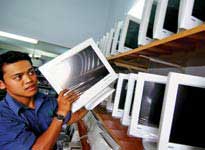For just over 100 USD and a willingness to use second-hand items, you can acquire a branded LCD monitor for your computer. However, you should carefully consider whether to buy or not to avoid bringing home a burden.
 |
|
Used LCD Monitor. Image: SGTT |
Most of the used monitors available in Vietnam are from reputable brands like Dell, IBM, and HP. The primary sources come from two places: the USA for monitors using Autovolt technology and from Japan for those using 110V. Based on experiences with computer products and electronic devices, along with confirmations from experts in computer components, it is noted that products originating from these countries are generally well-calibrated and of stable quality.
The prices of used monitors are typically half or two-thirds that of new LCD monitors of the same size from South Korean brands available in Vietnam. You can acquire a nearly new 15-inch LCD monitor for around 120 to 150 USD.
According to Mr. Trịnh Tiến Dũng from the technical department of Compuland, a company that previously specialized in selling used LCD monitors, compared to other used machinery, used LCD monitors are the least tampered with by sellers. When obtaining stock from importers, retailers must test each monitor individually rather than buying in bulk like CRT monitors or other electronic devices. The reason is simple: with used LCD monitors, any malfunctioning unit is typically discarded since there are not many places that specialize in repairs. It is rare to gather components from different faulty units to assemble a working one.
Cautions
Most used LCD monitors come with only a one-month warranty from sellers. Because there are not many specialized repair services, buyers may encounter difficulties when issues arise. If repair is possible, the cost of replacing the components can be equal to or even exceed the price of an entire monitor. Therefore, during the warranty period, if the product fails, the seller agrees to replace it with a new monitor. Once the warranty period is over, buyers must be prepared to dispose of the entire device.
Most used LCD monitors have been in use for a considerable time, meaning their remaining lifespan is limited. According to experts, it is unlikely that any of these monitors can be used for more than another one to two years. Additionally, these monitors were produced several years ago and lack the technological advancements that address previous shortcomings. As a result, these monitors often have narrow viewing angles; even a slight shift in position can make it difficult to see clearly. Furthermore, the colors on these LCDs are prone to issues, exhibiting dead pixels that create black or white spots, and sometimes clusters of streaks on the screen, which diminish image quality.
An important factor for LCD monitors is the response time. Currently, some LCD monitors have response times as low as 2 milliseconds, whereas many older models average around 14 milliseconds. Due to the slow response time, displaying fast-moving images, such as during movies or gaming, can result in choppiness. Additionally, the contrast and brightness of older LCD monitors do not match those of newer generations.
Buying Tips
If you choose to purchase a used LCD monitor, keep the following points in mind:
Check the production date on the back of the monitor to select one with the most recent manufacturing date, ensuring a longer lifespan.
According to computer technicians, it is advisable to opt for products that are on display running a demo, as sellers typically choose those that showcase good image quality for customer viewing.
For screen quality, consider bringing software that can identify dead pixels, such as the free software called “Dead Pixel Locator” (available for download at http://www.astris.com). With this software, you can set the monitor to display solid black, solid white, or any color to check for defects in the illuminated grid of the screen.
Vĩnh Phương


















































